

$10.10 Minimum Wage Would Save The U.S. Government $7.6 Billion A Year. Raising the federal minimum wage would save the government billions and have sweeping benefits for low-income families, according to a new analysis by the Economic Policy Institute, a think tank focused on labor issues.
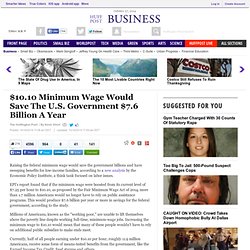
40 Percent of Restaurant Workers Live in Near-Poverty. It isn't just fast-food empires that rely on a low-paid, disempowered, and quite-often impoverished workforce.
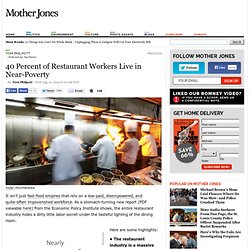
As a stomach-turning new report (PDF viewable here) from the Economic Policy Institute shows, the entire restaurant industry hides a dirty little labor secret under the tasteful lighting of the dining room. Here are some highlights: • The restaurant industry is a massive and growing source of employment. It accounts for more than 9 percent of US private-sector jobs—up from a little more than 7 percent in 1990.
That's nearly a 30 percent gain. • The industry's wages have stagnated at an extremely low level. . • Unionization rates are minuscule. . • As a result, the people who prepare and serve you food are pretty likely to live in poverty. . • Opportunity for advancement is pretty limited. . • Industry occupations are highly skewed along gender and race lines. . • Restaurants lean heavily on the most disempowered workers of all—undocumented immigrants. So what can you do? What’s wrong with supply-side economics.
While zipping through Netflix the other night, I came across a movie about bootleggers–that I wouldn‘t really recommend.
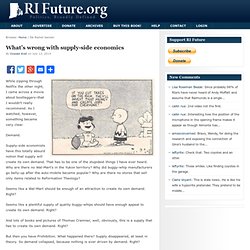
As I watched, however, something became very clear. Demand. Supply-side economists have this totally absurd notion that supply will create its own demand. That has to be one of the stupidest things I have ever heard. Why are there no Wal-Mart’s in the Yukon territory? Seems like a Wal-Mart should be enough of an attraction to create its own demand. Seems like a plentiful supply of quality buggy-whips should have enough appeal to create its own demand. And lots of books and pictures of Thomas Cramner, well, obviously, this is a supply that has to create its own demand.
Public Banking Institute - Banking in the Public Interest. American Cities with the Highest (and Lowest) Taxes. Tax season is here and, according to a recent report, American families in the nation's largest cities will be shelling out 15% or more of their income, and that doesn't even include federal taxes.
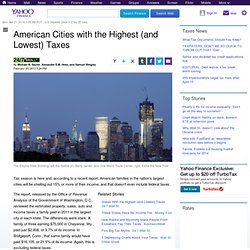
The report, released by the Office of Revenue Analysis of the Government of Washington, D.C., reviewed the estimated property, sales, auto and income taxes a family paid in 2011 in the largest city in each state. The differences were stark. A family of three earning $75,000 in Cheyenne, Wy., paid just $2,808, or 3.7% of its income. In Bridgeport, Conn., that same family would have paid $16,105, or 21.5% of its income. Again, this is excluding federal taxes. One of the biggest factors in how much a family can expect to pay is the state and local tax rates affecting their city. Personal income tax is one of the key factors. Another interesting trend was that cities with higher tax burdens tended to have higher unemployment, while lower-taxed cities tended to have among the lowest unemployment. Racial Wealth Gap Widened During Recession.
RI. Banking. Minimum Wage. The Downside to a Debt Jubilee - Breakingviews. The Unequal State of America: Redistributing Up. The 12 Companies Paying Americans the Least. The gap between rich and poor is well illustrated by the large multi-billion dollar corporations employing thousands of low-wage workers.
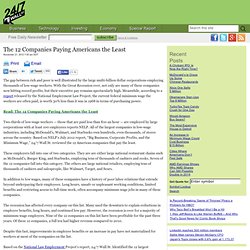
With the Great Recession over, not only are many of these companies now hitting record profits, but their executive pay remains spectacularly high. Meanwhile, according to a report released by the National Employment Law Project, the current federal minimum wage the workers are often paid, is worth 30% less than it was in 1968 in terms of purchasing power. Read: The 12 Companies Paying Americans the Least Two-thirds of low-wage workers — those that are paid less than $10 an hour — are employed by large corporations with at least 100 employees reports NELP.
All of the largest companies in low-wage industries, including McDonald’s, Walmart, and Starbucks own hundreds, even thousands, of stores across the country. Economics: Whatever happened to Keynes' 15-hour working week? asks Larry Elliott. Nobody ever dies saying "I wish I'd spent more time at the office", or so the saying goes.

We deeply regret those times the business trip or polishing off the report for the boss has meant missing the school play or cancelling the anniversary dinner. But if we would rather be spending more time with our loved ones than in making money, why don't we do so? If we believe that our priorities are all wrong, why don't we change them? That's certainly what John Maynard Keynes thought would happen. Back in 1930, Keynes predicted that the working week would be drastically cut, to perhaps 15 hours a week, with people choosing to have far more leisure as their material needs were satisfied.
Keynes had been working on Economic Possibilities for our Grandchildren before the Wall Street Crash of 1929 but finally published it a year into the crisis. But Keynes also got it spectacularly wrong.